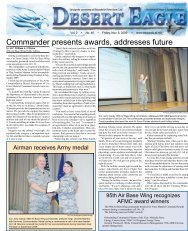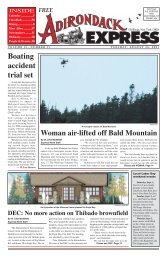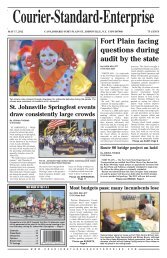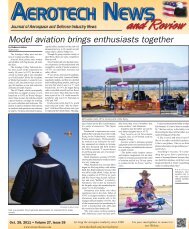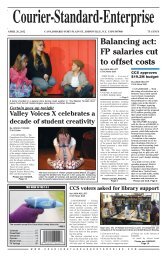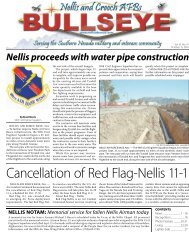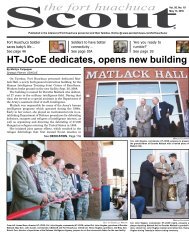Bullseye - Aerotech News and Review
Bullseye - Aerotech News and Review
Bullseye - Aerotech News and Review
Create successful ePaper yourself
Turn your PDF publications into a flip-book with our unique Google optimized e-Paper software.
BULLSEYE<br />
<strong>News</strong><br />
October 14, 2011<br />
Turn Energy Awareness into Action<br />
By Jennifer elmore<br />
Air Force Civil Engineer Support Agency<br />
TYNDALL AIR FORCE BASE, Fla. — Airmen<br />
across the Air Force are joining the nation to observe<br />
Energy Awareness Month, which is annually<br />
celebrated in October.<br />
This year’s theme, “Power the Force, Fuel the Fight,” encourages<br />
everyone to do more than just be “aware.” Instead,<br />
military personnel <strong>and</strong> civilians alike should take action.<br />
“The Air Force is making excellent progress toward<br />
satisfying federal energy m<strong>and</strong>ates,” said Rick<br />
Stacey, Air Force Facility Energy Center chief, who<br />
works in a division of the Air Force Civil Engineer<br />
Support Agency at Tyndall Air Force Base, Fla. “Some<br />
of the more prominent goals require us to reduce<br />
energy intensity 30 percent by 2015, reduce water<br />
intensity 26 percent by 2020 <strong>and</strong> increase renewable<br />
energy to 25 percent of all electricity use by 2025.<br />
But as time goes by, the goals are getting tougher.<br />
We need everyone doing all they can to help the Air<br />
Force continue our energy program successes.”<br />
The Air Force has reduced energy use nearly 15 percent,<br />
reduced its water consumption 11 percent <strong>and</strong> has<br />
used renewable sources for more than six percent of all its<br />
electricity needs since 2003. To meet these newer, more<br />
dem<strong>and</strong>ing goals, the Air Force energy strategy is to reduce<br />
dem<strong>and</strong>, increase supply <strong>and</strong> change the culture.<br />
Reduce dem<strong>and</strong><br />
The Air Force uses facility energy audits, utility<br />
meters, energy recommissioning <strong>and</strong> a variety of<br />
other tools to pursue aggressive reduction targets. At<br />
Kirtl<strong>and</strong> AFB, N.M., audits led to an upgraded energy<br />
management control system that is expected to save<br />
$3.7 million over the lifetime of the system. Newly<br />
installed meters at V<strong>and</strong>enberg AFB, Calif. allowed<br />
for better resource management <strong>and</strong> generated $2<br />
million of new revenue through more accurate billing<br />
of non-Department of Defense tenants. And Air<br />
Combat Comm<strong>and</strong>’s facility recommissioning, or<br />
building “tune-up,” program incurred enough energy<br />
savings to cut $433,000 from utility bills in 2010.<br />
Increase supply<br />
The Air Force leads the Department of Defense as<br />
the number one producer <strong>and</strong> user of renewable energy.<br />
More than six percent of the Air Force’s electric supply<br />
comes from on-base renewable energy projects including<br />
wind, solar, geothermal <strong>and</strong> l<strong>and</strong>fill gas.<br />
“We are evaluating ways to exp<strong>and</strong> our portfolio<br />
to include waste-to-energy <strong>and</strong> biomass projects as<br />
we work toward producing 25 percent renewable<br />
energy by 2025,” said Ken Gray, AFFEC Rates <strong>and</strong><br />
Renewable Branch chief.<br />
Two new wind turbines will come online this fall<br />
at the Massachusetts Military Reservation. Additionally,<br />
construction will soon begin on a 14-megawatt<br />
solar array at Davis-Monthan AFB, Ariz.<br />
Change the culture<br />
Our success, our ability to truly change the Air<br />
Force culture <strong>and</strong> develop a new mindset when it<br />
comes to energy, depends on each Airman.<br />
“Each individual can <strong>and</strong> must contribute,” said<br />
Stacey. “No matter how small or how large the action,<br />
people will ultimately make the difference.<br />
Take a moment to turn off lights <strong>and</strong> appliances<br />
when not in use; make saving energy <strong>and</strong> water a<br />
habit every day; <strong>and</strong> encourage your family, friends<br />
<strong>and</strong> co-workers to do their part, too.”<br />
Take “ACTION” this Energy Awareness Month.<br />
A-C-T-I-O-N st<strong>and</strong>s for: Appliance reduction,<br />
Computer log off, Temperature set points, Inform<br />
facility managers, Outdoor conservation <strong>and</strong> No<br />
waste. These are easy steps that can yield positive<br />
results for the community <strong>and</strong> the Air Force.<br />
OctOber is energy<br />
AwAreness MOnth<br />
• Appliance reduction – Look around the workspace.<br />
Is there a refrigerator or coffee maker nearby?<br />
How many personal appliances can be removed or<br />
consolidated in common areas, like a break room?<br />
Reducing energy usage by reducing the number of<br />
appliances <strong>and</strong> machines available can yield significant<br />
energy savings. For example, in an evaluation<br />
of just two buildings at Wright-Patterson AFB,<br />
Ohio, the base energy manager found a staggering<br />
810 appliances that could be unplugged or eliminated.<br />
The list included radios, fans, refrigerators,<br />
coffee makers, microwaves <strong>and</strong> toasters.<br />
• Computer log off – Everyone should log-off at the<br />
end of the day. This ensures that computers will enter<br />
energy-saving sleep mode. The Air Force Information<br />
Technology Power Management Team estimates this<br />
action alone can save more than $10 million a year.<br />
• Temperature Control – Climate control set points<br />
can have a major impact on energy use. Most bases<br />
use settings of 68 degrees in the winter <strong>and</strong> 78 degrees<br />
in the summer. Heating <strong>and</strong> cooling systems are not<br />
perfect, so workspaces may not be at optimum comfort<br />
temperatures. Rather than increasing energy dem<strong>and</strong><br />
with space heaters or fans, dress appropriately for the<br />
temperature. If the building is too cool in the summer or<br />
too hot in the winter, the thermostat could be set incorrectly,<br />
which means the Air Force is wasting energy.<br />
• Inform the facility manager – Report incorrect<br />
temperature set points, leaky faucets, blocked air vents,<br />
cracked windows <strong>and</strong> other problems to the facility<br />
manager or civil engineering customer service.<br />
• Outdoor conservation – If a broken sprinkler<br />
head is wasting water or area lights are left on in<br />
a parking lot during the day, report it to the local<br />
Civil Engineer Customer Service.<br />
• No waste – Do not turn a blind eye to problems.<br />
If something is on that does not need to be, turn it<br />
off. If there is a problem, report it.<br />
All military personnel <strong>and</strong> civilians should review<br />
their daily routines to conserve energy <strong>and</strong> water, <strong>and</strong><br />
they should empower themselves <strong>and</strong> others to take<br />
action. Every dollar saved on energy is a dollar that can<br />
be spent to “Power the Force, Fuel the Fight.”



